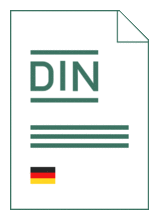
Standard [WITHDRAWN]
DIN 50930-6:2013-10
Corrosion of metals - Corrosion of metallic materials under corrosion load by water inside of pipes, tanks and apparatus - Part 6: Evaluation process and requirements regarding the hygienic suitability in contact with drinking water
- German title
- Korrosion der Metalle - Korrosion metallener Werkstoffe im Innern von Rohrleitungen, Behältern und Apparaten bei Korrosionsbelastung durch Wässer - Teil 6: Bewertungsverfahren und Anforderungen hinsichtlich der hygienischen Eignung in Kontakt mit Trinkwasser
- Publication date
- 2013-10
- Original language
- German
- Pages
- 27
- Note
- The issuing body recommends using {0} DVGW W 551-8:2023-11, TrinkwMetallWerkstoffBewGBek:2020-05-14 .
- Publication date
- 2013-10
- Original language
- German
- Pages
- 27
- Note
- The issuing body recommends using {0} DVGW W 551-8:2023-11, TrinkwMetallWerkstoffBewGBek:2020-05-14 .
- DOI
- https://dx.doi.org/10.31030/2056720
Product information on this site:
Quick delivery via download or delivery service
All transactions are encrypted
This document has been prepared by Working Committee NA 062-01-71 AA "Korrosion und Korrosionsschutz" ("Corrosion and corrosion protection") of the Standards Committee Materials Testing in close cooperation with the Deutscher Verein des Gas- und Wasserfaches e. V. (DVGW) (German Technical and Scientific Association for Gas and Water). The changes to metallic materials by corrosion and measures that can be taken to prevent corrosion are covered in the European standards series DIN EN 12502. However, this series does not deal with the changes in the quality of the drinking water due to contact with metallic materials; thus, DIN 50930-6 will be retained as a national regulation even upon publication of the DIN EN 12502 standard series. As of December 1, 2013, a lower threshold value of 10 µg/l for lead in drinking water came into force in accordance with the Trinkwasserverordnung (German Drinking Water Ordinance of 2001 - TrinkwV 2001). 8.7.1, 8.7.2 and 8.7.3 in DIN 50930-6:2001-08 define materials for fittings and pipe connections which can be used without restriction for all drinking waters. These materials were still permitted to be used until the new threshold value for lead in accordance with the Drinking Water Ordinance took effect on December 1, 2013. Metallic materials proven to be suitable for hygienic drinking water use can be found on the list issued by the Umweltbundesamt (Federal Environment Agency - UBA), "Empfehlung des Umweltbundesamts - Trinkwasserhygienisch geeignete metallene Werkstoffe" (Recommendation of the Federal Environmental Agency on metallic materials hygienically suitable for contact with drinking water). This standard defines hygienic requirements for metallic materials. These requirements are intended to ensure that the binding specifications of the Drinking Water Ordinance (TrinkwV 2001) can be complied with when these materials are used for products in contact with drinking water (for example, pipes, pipe connections, fittings, water meters, appliances). The evaluation of the results of testing a material in accordance with DIN EN 15664-1 and DIN EN 15664-2 described in this standard enables the hygienic suitability of a metallic material to be determined, either with a local drinking water or with all drinking waters. Certain pipe materials cannot be used in all drinking waters or under all operating conditions. The additional requirements for the restricted use of pipe materials with drinking water of a certain quality are also part of this standard. The assessment of materials according to this standard is limited to installations for cold drinking water. However, the materials receiving positive evaluations can also be used with drinking water which has been heated, as long as the limitations outlined in clause 6 are taken into consideration. Protective measures for existing drinking water installations whose operating conditions or age could result in the parameters being exceeded are described in clause 7. If the legal requirements for drinking water quality cannot be met in existing installation systems as a result of unfavourable water compositions and operating conditions or improper choice of materials, the impermissible changes in the drinking water quality can be counteracted by protective measures. The effectiveness of these measures can be evaluated using the specifications in this standard. Corrosion processes which lead to damage to the component are not covered by this standard.
This document replaces DIN 50930-6:2001-08 .
